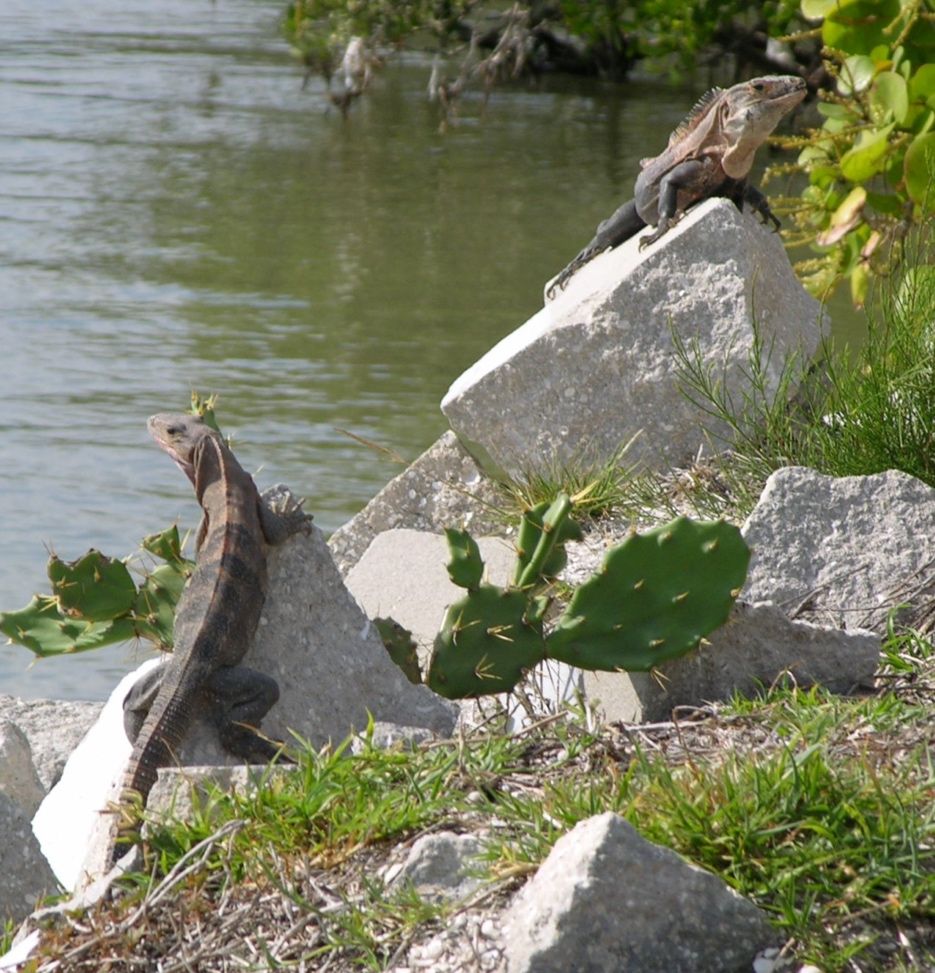You thought your college roommate was bad!

Gopher tortoises (Gopherus polyphemus) are the architects, builders, and apartment supers of the woods in Florida. Their capacious burrows provide relatively safe and comfortable living quarters for native frogs, snakes, small mammals, a few birds, and countless arthropods. Most of these animals make pretty good tenants, politely sharing living quarters with tortoises and causing few problems. But for the past 40 years or so, gopher tortoises on Gasparilla Island, Florida, have been dealing with a new kind of housemate. A rude and raucous one that breaks all the rules and denies the gentle, placid gopher tortoise the right to peaceful enjoyment of its home. This destroyer of wildlife property values is the black spiny-tailed iguana, or Ctenosaura similis. Recent UF/IFAS research suggests that in disputes between gopher tortoises and iguana interlopers, usually the iguanas prevail and the tortoises are the ones evicted.
How did this happen?
A recent EDIS publication, “History, Status, Impacts, and Management of Invasive Black Spiny-Tailed Iguanas (Ctenosaura similis) on Gasparilla Island, Florida,” provides the facts. Like so many of Florida’s problem invasive species, Gulf Coast Florida’s black spiny-tailed iguanas started out as pets. Three pets, in this case. DNA testing shows that nearly the entire Florida Gulf Coast population of this species of lizard traces back to three individual pet iguanas a resident of Gasparilla Island acquired in Mexico and raised with his children.
This all went down in the 1970s, before the Burmese python invasion of the Everglades and before Florida’s problems with invasive species were common knowledge. So when the iguanas became too much to take care of, or when the family mistakenly believed it would be kind to set them free, they simply released them. Those three black spiny tailed iguanas released in the early eighties are the forebears of the entire population on the west coast of Florida today.

Problems black spiny-tailed iguanas cause people
Iguanas are voracious eaters and will strip foliage from plants and ravage yards. Worse, if they don’t happen to find a gopher tortoise burrow to take over, they are perfectly capable of digging their own burrows, and they like to situate those burrows under sidewalks and foundations and in and under walls, causing all manner of structural problems. They sometimes invade people’s houses and nest in attics. And, as with seemingly every other invasive amphibian or reptile, they are occasionally found in toilets. Not. Optimal.
Problems they cause in the environment
Recent UF/IFAS research found evidence that black spiny-tailed iguanas have been evicting gopher tortoises from their own burrows. Young tortoises unable to stay in their first burrows because iguanas have moved in are forced to dig new burrows. The extra work exhausts them and burns up energy they otherwise could spend finding food. Scientists are concerned about the effects the displacement may be having on gopher tortoises, already a vulnerable species because of habitat loss. Additionally, according to authors Sean L. McKnight, Bryan M. Kluever, Parker Hall, Miguel A. Acevedo, and Steve A. Johnson, besides kicking gopher tortoises out of their burrows, black spiny-tailed iguanas could be harming loggerhead sea turtles, green sea turtles, least terns, and snowy plovers. They eat hatchling turtles and baby tortoises, and they eat birds’ eggs.

What can you do?
Plenty, as it turns out. Above all, you can be a responsible pet owner and never release a pet iguana, or any pet, into the wild. Beyond that, if you live near populations of iguanas, you can cooperate with wildlife managers and allow trappers to remove iguanas from your property. You can protect vegetables and tender landscape plants with tough screens to keep out hungry iguanas, and you can select iguana-unfriendly plants to discourage them from taking up residence in your yard. Find out how here, and share what you learn with friends and neighbors to redouble your impact. To learn more about Florida’s constant battles with invasive reptiles and amphibians, consult Ask IFAS.
 4
4
